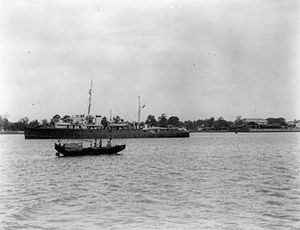HMIS Indus (U67)

Indus in Akyab harbour, Burma, 1942
|
|
| History | |
|---|---|
|
|
|
| Name: | Indus |
| Namesake: | Indus |
| Builder: | Hawthorn Leslie and Company |
| Laid down: | 8 December 1933 |
| Launched: | 24 August 1934 |
| Commissioned: | 15 March 1935 |
| Identification: | Pennant number: L67 (U67 after 1940) |
| Fate: | Sunk by Japanese aircraft off Akyab, 6 April 1942 |
| General characteristics | |
| Class and type: | Grimsby class sloop |
| Displacement: | 1,190 long tons (1,210 t) standard load |
| Length: | 296 ft 4 in (90.32 m) oa |
| Beam: | 35 ft 6 in (10.82 m) |
| Draught: | 10 ft 9 in (3.28 m) |
| Propulsion: |
|
| Speed: | 16.25 kn (30.10 km/h; 18.70 mph) |
| Complement: | 119 |
| Armament: |
|
HMIS Indus was a Grimsby-class sloop of the Royal Indian Navy launched in 1934 and sunk during the Second World War in 1942. She was a slightly enlarged version of other vessels in the Grimsby class. She was named after the Indus River. Indus served mainly as an escort vessel, and she was therefore lightly armed. Her pennant number was changed to U67 in 1940.
Indus was a part of the Eastern Fleet during the war.
In March 1942, British Indian Army and British Army troops from Rangoon had to be withdrawn, as they were overwhelmed by the superior numbers as well as the air command of the Japanese. Akyab was the next port to be attacked by the Japanese in April. The Flag-Officer-Commanding of the Eastern Fleet refused to withdraw Indus and Sutlej from the anti-infiltration patrol off Akyab. On 6 April, Indus suffered 3 direct bomb hits in an air raid by Japanese Mitsubishi G3M bombers, and sank in 35 minutes. There was no loss of life to her crew although 10 were injured.
On 6 April 1942 Indus was bombed and sunk by Japanese aircraft off Akyab, Burma in position 20°7′N 92°54′E / 20.117°N 92.900°ECoordinates: 20°7′N 92°54′E / 20.117°N 92.900°E
...
Wikipedia
